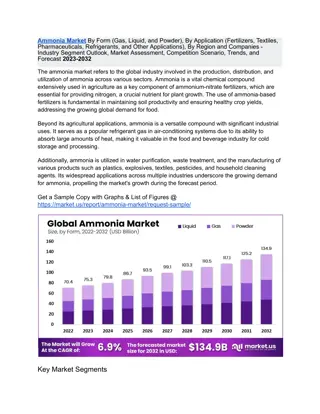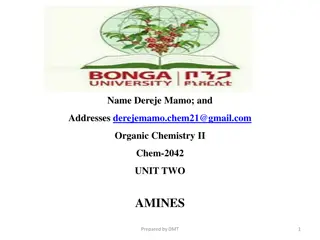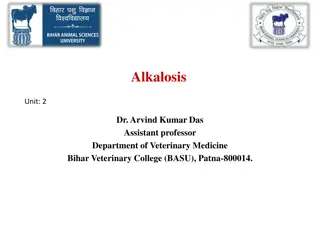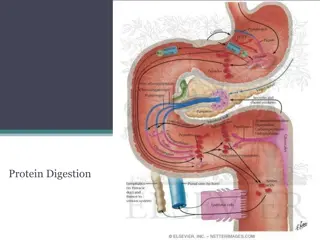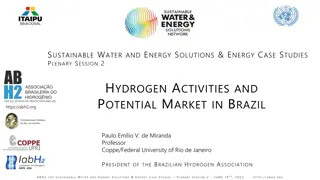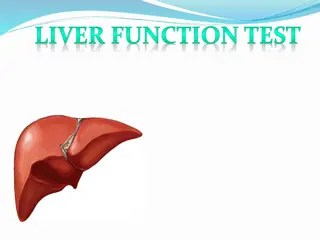ASPEN Staged Separation Unit-Ops
Introduction to Aspen Staged Separation Unit Operations for the purification of desired components by removing impurities and pollutants using distillation, absorption, and stripping columns. This technology is relevant to ammonia synthesis to prevent catalyst poisoning by removing CO2 through absor
0 views • 26 slides
Global Green Ammonia Market
The Global Green Ammonia Market Size is expected to reach USD 60.45 Billion by 2033, at a CAGR of 71.1% during the forecast period 2023 to 2033.\n\n
0 views • 4 slides
Aspen Simulation of Steam Reforming and Haber-Bosch Processes in Kinetics Reactors
Aspen simulation showcases the kinetics reactors for steam reforming of natural gas and the Haber-Bosch process for ammonia production. Steam reforming is highly endothermic, producing hydrogen and CO, while the Haber-Bosch process is exothermic, crucial for ammonia synthesis. The RPlug reactor and
4 views • 26 slides
Overview of Heavy Chemicals Manufacturing Process
The field of industrial chemistry involves the large-scale preparation of heavy chemicals, which are chemicals produced and used commercially. This process requires an understanding of various physico-chemical principles and specific manufacturing techniques for chemicals like Ammonia, Sulphuric Aci
3 views • 30 slides
Get the best Anti Frizz Treatment in Pasir Ris
Get the best Anti Frizz Treatment in Pasir Ris at DE HAIR PROFILE frizz control specialist. With humble yet determined leadership, they relentlessly pursue greatness in the hair industry. As an ethical, cruelty-free brand, they prioritize the well-being of hairdressers. Their range of ammonia-free h
2 views • 6 slides
Investments in Ammonia Infrastructure Set to Boost Market Growth
Ammonia Market By Form (Gas, Liquid, and Powder), By Application (Fertilizers, Textiles, Pharmaceuticals, Refrigerants, and Other Applications), By Region and Companies - Industry Segment Outlook, Market Assessment, Competition Scenario, Trends, and
1 views • 3 slides
Nitrogen Fixation Process in Plants
Nitrogen fixation is the conversion of atmospheric nitrogen into ammonia or nitrates by bacteria or industrial processes for plant absorption. Biological and abiological methods exist, with various bacteria and cyanobacteria involved in the process. Symbiotic relationships between these organisms an
1 views • 10 slides
Urea Biosynthesis and the Krebs-Henseleit Cycle in the Liver
Urea is synthesized in the liver through a series of enzymatic steps known as the urea cycle or Krebs-Henseleit cycle. This process involves converting toxic ammonia into urea, a less toxic and water-soluble compound that can be easily excreted in urine. The liver plays a crucial role in urea biosyn
1 views • 20 slides
Nitrogen Metabolism: Amino Acid Biosynthesis and Ammonia Incorporation
Nitrogen metabolism is crucial in the biosynthesis of amino acids such as glutamate and glutamine, incorporating ammonia for various physiological processes. Ammonia is efficiently transported and stored using compounds like alanine and glutamate, playing a key role in the urea cycle. Glutamate, a v
0 views • 22 slides
Green Hydrogen (Ammonia) Outlook: Europe-Egypt Case Study
This study explores the green hydrogen (ammonia) outlook in Europe and Egypt, focusing on opportunities, challenges, and the techno-economic, geopolitical, and regulatory factors. It discusses the surge in ammonia prices due to the Russian-Ukrainian conflict, the expected ammonia production capacity
0 views • 10 slides
Nitrogen Fixation and Symbiotic Relationship in Agriculture
Nitrogen fixation is a crucial process where nitrogen is converted into ammonia by nitrogen-fixing bacteria, benefiting plants like legumes. Symbiotic nitrogen fixation involves a mutualistic exchange between plants and bacteria, exemplified by Rhizobium species. This symbiosis leads to the conversi
0 views • 15 slides
Amines in Organic Chemistry: Structure, Nomenclature, and Importance
Amines are organic derivatives of ammonia with a nitrogen atom containing a lone pair of electrons, making them basic and nucleophilic. They play crucial roles in living organisms, such as being building blocks of proteins and constituents of nucleic acids. Learn about the structure, nomenclature, a
2 views • 70 slides
Amines in Organic Chemistry
Amines are organic compounds derived from ammonia, with different classifications based on the number of attached organic groups. They play vital roles in various biological processes, such as metabolism and structure formation. Biogenic amines are essential for life processes in living organisms. E
1 views • 31 slides
Alkalosis in Cattle: Causes and Pathophysiology
Alkalosis in cattle, particularly ruminal alkalosis, can be caused by issues such as abomasal atony and alkaline indigestion. Excessive intake of protein-rich feed and changes in diet play a significant role. Pathophysiology involves the accumulation of ruminal ammonia, leading to alkaline pH and ru
1 views • 13 slides
Overview of Ammonium Chloride: Properties, Preparation, and Uses
Ammonium Chloride, with the formula NH4Cl, is a compound containing not less than 99.5% NH4Cl. It is prepared commercially by neutralizing ammonia with hydrochloric acid or treating ammoniacal gas liquors with lime. The compound is essential for maintaining acid-base equilibrium, acts as an expector
2 views • 4 slides
The Urea Cycle in Biochemistry
Explore the intricate process of the urea cycle, its role in removing amino groups from amino acids, converting ammonia into urea in the liver, and managing hyperammonemia. Learn about transamination, oxidative deamination, and the importance of glutamine and alanine in ammonia transport. Discover t
1 views • 26 slides
Protein Digestion and Amino Acid Metabolism
The process of protein digestion involves proteolytic enzymes produced by the stomach, pancreas, and small intestine. Pepsinogen is activated to pepsin in the stomach, breaking down proteins into oligopeptides and amino acids. After absorption, amino acids are utilized for protein synthesis and as d
0 views • 7 slides
Process Safety Incidents and Prevention Best Practices
Process safety incidents involving hazardous materials like caustic solutions, ammonia leaks, and TFE have caused injuries and fatalities. Key incidents include burns from caustic exposure, fatalities due to ammonia leaks, and an explosion from improper TFE handling. Learning from these incidents hi
7 views • 21 slides
GH2 Hydrogen Namibia Stakeholders Conference: Exploring By-Products and Market Opportunities
The GH2 Hydrogen Namibia Stakeholders Conference delves into the potential of GH2 technology as a disruptive innovation, creating new industries and opportunities. Discussions revolve around GH2 by-products like ammonia and methanol, exploring their domestic and foreign market applications. Collabor
0 views • 6 slides
Urea Cycle: An Overview of Ammonia Detoxification and Urea Formation
Understand the intricate process of ammonia detoxification through the urea cycle, where amino groups from amino acids are converted to urea for disposal. Learn about the importance of transamination reactions, blood transport of ammonia to the liver, and causes and management of hyperammonemia. Exp
0 views • 26 slides
Overview of Acyl Chlorides in Organic Chemistry
Acyl chlorides, also known as acid chlorides, are important compounds in organic chemistry. They can be prepared from carboxylic acids and thionyl chloride, and are reactive towards various nucleophiles leading to the formation of carboxylic acid esters, primary and secondary amides. Acyl chlorides
0 views • 5 slides
Nitrogen: Properties, Reactions, and Applications
Nitrogen, a colorless and odorless gas, is a vital element present in air and plays a crucial role in various chemical reactions. Known for its unreactive nature due to strong bonds, nitrogen is used in the manufacture of ammonia, fertilizers, and organic compounds. Discover how nitrogen is prepared
0 views • 43 slides
Qualitative Analysis of Cations in Chemistry Experiments
Explore the qualitative analysis of cations such as calcium, aluminum, zinc, and lead through various tests with reagents like sodium hydroxide and ammonia. Learn how to observe and distinguish different cations based on their distinct reactions and characteristics in solution. The tests provide ins
0 views • 18 slides
Solvents for Chemistry Enthusiasts
Explore the power of solvents with Dr. A. Stella Shalini, Assistant Professor of Chemistry at St. Joseph's College, Trichy-2. Learn about the properties of water as a universal solvent, its ability to dissolve substances like salt, and non-aqueous solvents such as liquid ammonia. Discover the classi
0 views • 8 slides
Developing Network Models of Industrial Symbiosis - A Comprehensive Overview
Exploring the concept of Industrial Symbiosis (IS) and its significance in waste management solutions through physical material exchange and collaboration. The possibilities and linkages in CO2 network allocation and input-output analyses for Ammonia and Methanol plants are discussed, shedding light
0 views • 19 slides
Essential Laundry Tips: Washing Instructions, Clothing Preparation & Bleach Safety
Understanding the importance of reading garment labels before laundering, proper clothing preparation tips, knowing which types of clothing to wash in hot, warm, or cold water, precautions for using chlorine bleach, benefits of powdered oxygen bleach, and why chlorine and ammonia should never be mix
0 views • 16 slides
Ammonia Reactor System Design and Optimization Study for High Efficiency
This material discusses the design and optimization of an ammonia synthesis reactor system for maximizing conversion efficiency while minimizing CAPEX costs. Various factors such as managing heat effects, reaction runaway prevention, and cooling profiles are explored. Recommendations include using a
3 views • 10 slides
Tank Car NAR Data Breakdowns 2017 Preliminary Overview
Preliminary data breakdowns for Tank Car NAR incidents in 2017 sourced from PHMSA and Canadian railroads. Details on incident sources, gaps in Cause Codes, reductions in NARs since previous years, top commodities involved, and multiple NAR occurrences from the same origin points. Graphs depict trend
0 views • 16 slides
Systems-Oriented Concept Map Extension for Reactive Nitrogen Flows
International Organization for Chemical Sciences in Development presents a Systems-Oriented Concept Map Extension (SOCME) focusing on biogeochemical flows of reactive nitrogen from NH3. The concept explores core reaction subsystems, energy input subsystems, equilibrium conditions, and the integratio
0 views • 11 slides
Sustainable Water and Energy Solutions: Hydrogen Activities and Market Potential in Brazil
Professor Paulo Emílio V. de Miranda discusses sustainable water and energy solutions, focusing on hydrogen activities and the potential market in Brazil. The presentation covers various renewable energy sources, such as hydroelectric power, geothermal energy, solar energy, biogas, and more. It als
0 views • 5 slides
Advantages of Recirculating Aquaculture Systems for Sustainable Fish Production
Recirculating aquaculture technology offers numerous benefits such as water reuse, minimized water consumption, enhanced biosecurity, and cost-effectiveness. By adopting recirculating systems, aquaculture farms can comply with stricter regulations, address water scarcity issues, and optimize product
0 views • 13 slides
Applications of Density Functional Theory (DFT) in Various Fields
Density Functional Theory (DFT) is a powerful computational tool used in various scientific fields to understand complex chemical and physical phenomena. This theory allows for detailed analysis and prediction of material properties, reactions, and structures at the atomic level. Through the example
0 views • 55 slides
Liver Function Tests and Their Significance
The liver carries out essential metabolic, excretory, protective, synthetic, and storage functions in the body. Liver function tests play a crucial role in screening for liver dysfunction, recognizing patterns of liver disease, assessing patient prognosis, monitoring disease progression, and evaluat
0 views • 48 slides
Efficient Photocatalytic Reduction of Dinitrogen to Ammonia Using Bismuth Monoxide Quantum Dots
N2 reduction to ammonia by solar light offers a sustainable approach to combating global warming and energy crises. Bismuth monoxide quantum dots demonstrate high efficiency in catalyzing this process without the need for sacrificial agents or co-catalysts, achieving a significant increase in ammoni
0 views • 24 slides
Amines: Structure, Properties, and Uses
Amines are derivatives of ammonia with alkyl or aryl groups replacing hydrogen atoms, making them more basic due to the presence of an unshared electron pair on the nitrogen atom. This summary covers the order of basicity, key compounds like Ethylene Diamine and Amphetamine, as well as their structu
0 views • 4 slides
Cost-effective Measures to Reduce Ammonia Emissions in Agriculture
Cost-effective strategies to reduce ammonia emissions in agriculture are crucial in Latvia, where a significant portion of emissions originate from the agricultural sector. The study focuses on potential measures, such as precise mineral fertilizer application, improved manure management, nitrogen f
0 views • 13 slides
Detecting Cobalt(II) Ion Reactions in Solutions
This experiment outlines various methods for detecting Cobalt(II) ions (Co2+) in solution using reagents like sodium hydroxide, ammonia, sodium or potassium carbonate, and more. Observations and changes in color are noted throughout the process to identify the presence of the Cobalt ions. The reacti
0 views • 19 slides
Public Participation in Industrial Emissions Directive: Case Study on Ammonia Production
The case study focuses on public participation aspects in the context of the Industrial Emissions Directive for an ammonia production facility located near borders of multiple countries. It includes details on the installation's location, potential impacts, and challenges related to notification of
0 views • 8 slides
Fertilizer Application and Cost Analysis for Soil Nutrients
This detailed agricultural analysis discusses the cost-effectiveness of applying anhydrous ammonia versus urea based on nitrogen content per pound, provides recommendations for nitrogen rates based on yield goals and soil analysis, calculates pounds of nutrients and fillers in a fertilizer blend, an
0 views • 7 slides
Preparation of Calcium Peroxide (CaO2) in Inorganic Chemistry Practical II
This practical experiment details the preparation of calcium peroxide, a solid peroxide used in various industries and agriculture. The procedure involves the reaction of calcium salt and sodium peroxide to synthesize calcium peroxide, which has applications in agriculture, aquaculture, ecological r
0 views • 7 slides





